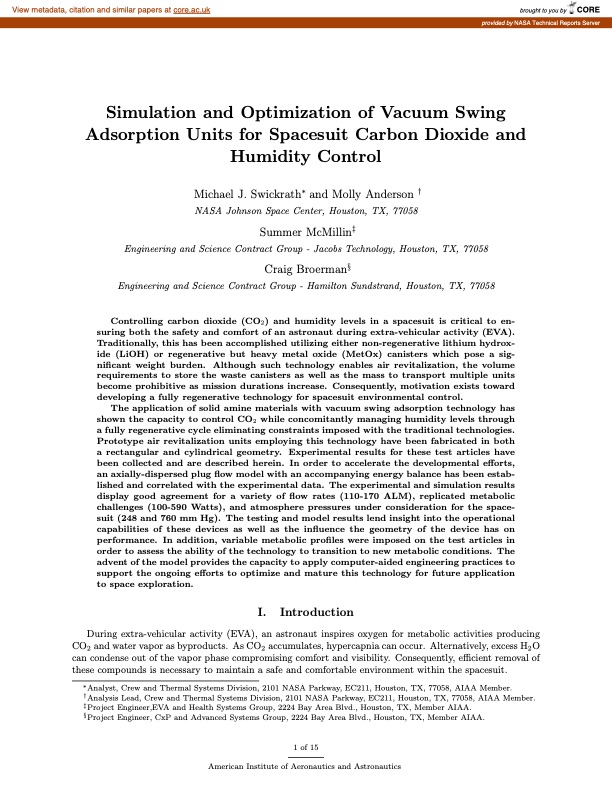
PDF Publication Title:
Text from PDF Page: 001
https://ntrs.nasa.gov/search.jsp?R=20110011193 2019-08-30T15:25:26+00:00Z View metadata, citation and similar papers at core.ac.uk brought to you by CORE provided by NASA Technical Reports Server Simulation and Optimization of Vacuum Swing Adsorption Units for Spacesuit Carbon Dioxide and Humidity Control Michael J. Swickrath∗ and Molly Anderson † NASA Johnson Space Center, Houston, TX, 77058 Summer McMillin‡ Engineering and Science Contract Group - Jacobs Technology, Houston, TX, 77058 Craig Broerman§ Engineering and Science Contract Group - Hamilton Sundstrand, Houston, TX, 77058 Controlling carbon dioxide (CO2) and humidity levels in a spacesuit is critical to en- suring both the safety and comfort of an astronaut during extra-vehicular activity (EVA). Traditionally, this has been accomplished utilizing either non-regenerative lithium hydrox- ide (LiOH) or regenerative but heavy metal oxide (MetOx) canisters which pose a sig- nificant weight burden. Although such technology enables air revitalization, the volume requirements to store the waste canisters as well as the mass to transport multiple units become prohibitive as mission durations increase. Consequently, motivation exists toward developing a fully regenerative technology for spacesuit environmental control. The application of solid amine materials with vacuum swing adsorption technology has shown the capacity to control CO2 while concomitantly managing humidity levels through a fully regenerative cycle eliminating constraints imposed with the traditional technologies. Prototype air revitalization units employing this technology have been fabricated in both a rectangular and cylindrical geometry. Experimental results for these test articles have been collected and are described herein. In order to accelerate the developmental efforts, an axially-dispersed plug flow model with an accompanying energy balance has been estab- lished and correlated with the experimental data. The experimental and simulation results display good agreement for a variety of flow rates (110-170 ALM), replicated metabolic challenges (100-590 Watts), and atmosphere pressures under consideration for the space- suit (248 and 760 mm Hg). The testing and model results lend insight into the operational capabilities of these devices as well as the influence the geometry of the device has on performance. In addition, variable metabolic profiles were imposed on the test articles in order to assess the ability of the technology to transition to new metabolic conditions. The advent of the model provides the capacity to apply computer-aided engineering practices to support the ongoing efforts to optimize and mature this technology for future application to space exploration. I. Introduction During extra-vehicular activity (EVA), an astronaut inspires oxygen for metabolic activities producing CO2 and water vapor as byproducts. As CO2 accumulates, hypercapnia can occur. Alternatively, excess H2O can condense out of the vapor phase compromising comfort and visibility. Consequently, efficient removal of these compounds is necessary to maintain a safe and comfortable environment within the spacesuit. ∗Analyst, Crew and Thermal Systems Division, 2101 NASA Parkway, EC211, Houston, TX, 77058, AIAA Member. †Analysis Lead, Crew and Thermal Systems Division, 2101 NASA Parkway, EC211, Houston, TX, 77058, AIAA Member. ‡Project Engineer,EVA and Health Systems Group, 2224 Bay Area Blvd., Houston, TX, Member AIAA. §Project Engineer, CxP and Advanced Systems Group, 2224 Bay Area Blvd., Houston, TX, Member AIAA. 1 of 15 American Institute of Aeronautics and AstronauticsPDF Image | Vacuum Swing Adsorption Units for Spacesuit Carbon Dioxide and Humidity Control

PDF Search Title:
Vacuum Swing Adsorption Units for Spacesuit Carbon Dioxide and Humidity ControlOriginal File Name Searched:
10559884.pdfDIY PDF Search: Google It | Yahoo | Bing
CO2 Organic Rankine Cycle Experimenter Platform The supercritical CO2 phase change system is both a heat pump and organic rankine cycle which can be used for those purposes and as a supercritical extractor for advanced subcritical and supercritical extraction technology. Uses include producing nanoparticles, precious metal CO2 extraction, lithium battery recycling, and other applications... More Info
Heat Pumps CO2 ORC Heat Pump System Platform More Info
| CONTACT TEL: 608-238-6001 Email: greg@infinityturbine.com | RSS | AMP |